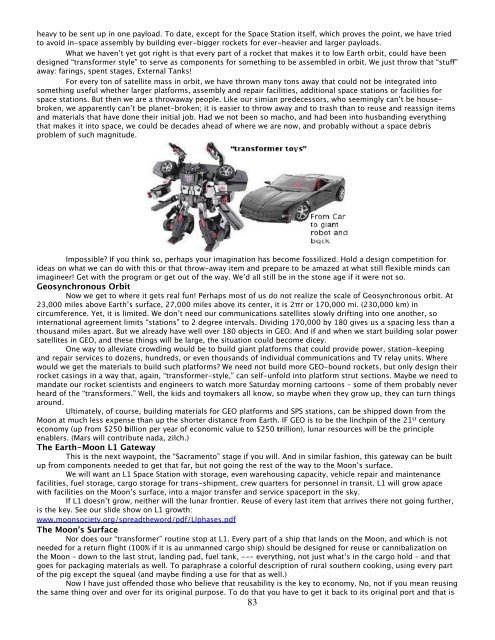Space Transportation - mmmt_transportation.pdf - Moon Society
Space Transportation - mmmt_transportation.pdf - Moon Society
Space Transportation - mmmt_transportation.pdf - Moon Society
You also want an ePaper? Increase the reach of your titles
YUMPU automatically turns print PDFs into web optimized ePapers that Google loves.
heavy to be sent up in one payload. To date, except for the <strong>Space</strong> Station itself, which proves the point, we have tried<br />
to avoid in-space assembly by building ever-bigger rockets for ever-heavier and larger payloads.<br />
What we haven’t yet got right is that every part of a rocket that makes it to low Earth orbit, could have been<br />
designed “transformer style” to serve as components for something to be assembled in orbit. We just throw that “stuff”<br />
away: farings, spent stages, External Tanks!<br />
For every ton of satellite mass in orbit, we have thrown many tons away that could not be integrated into<br />
something useful whether larger platforms, assembly and repair facilities, additional space stations or facilities for<br />
space stations. But then we are a throwaway people. Like our simian predecessors, who seemingly can’t be housebroken,<br />
we apparently can’t be planet-broken; it is easier to throw away and to trash than to reuse and reassign items<br />
and materials that have done their initial job. Had we not been so macho, and had been into husbanding everything<br />
that makes it into space, we could be decades ahead of where we are now, and probably without a space debris<br />
problem of such magnitude.<br />
Impossible? If you think so, perhaps your imagination has become fossilized. Hold a design competition for<br />
ideas on what we can do with this or that throw-away item and prepare to be amazed at what still flexible minds can<br />
imagineer! Get with the program or get out of the way. We’d all still be in the stone age if it were not so.<br />
Geosynchronous Orbit<br />
Now we get to where it gets real fun! Perhaps most of us do not realize the scale of Geosynchronous orbit. At<br />
23,000 miles above Earth’s surface, 27,000 miles above its center, it is 2πr or 170,000 mi. (230,000 km) in<br />
circumference. Yet, it is limited. We don’t need our communications satellites slowly drifting into one another, so<br />
international agreement limits “stations” to 2 degree intervals. Dividing 170,000 by 180 gives us a spacing less than a<br />
thousand miles apart. But we already have well over 180 objects in GEO. And if and when we start building solar power<br />
satellites in GEO, and these things will be large, the situation could become dicey.<br />
One way to alleviate crowding would be to build giant platforms that could provide power, station-keeping<br />
and repair services to dozens, hundreds, or even thousands of individual communications and TV relay units. Where<br />
would we get the materials to build such platforms? We need not build more GEO-bound rockets, but only design their<br />
rocket casings in a way that, again, “transformer-style,” can self-unfold into platform strut sections. Maybe we need to<br />
mandate our rocket scientists and engineers to watch more Saturday morning cartoons – some of them probably never<br />
heard of the “transformers.” Well, the kids and toymakers all know, so maybe when they grow up, they can turn things<br />
around.<br />
Ultimately, of course, building materials for GEO platforms and SPS stations, can be shipped down from the<br />
<strong>Moon</strong> at much less expense than up the shorter distance from Earth. IF GEO is to be the linchpin of the 21<br />
83<br />
st century<br />
economy (up from $250 billion per year of economic value to $250 trillion), lunar resources will be the principle<br />
enablers. (Mars will contribute nada, zilch.)<br />
The Earth-<strong>Moon</strong> L1 Gateway<br />
This is the next waypoint, the “Sacramento” stage if you will. And in similar fashion, this gateway can be built<br />
up from components needed to get that far, but not going the rest of the way to the <strong>Moon</strong>’s surface.<br />
We will want an L1 <strong>Space</strong> Station with storage, even warehousing capacity, vehicle repair and maintenance<br />
facilities, fuel storage, cargo storage for trans-shipment, crew quarters for personnel in transit. L1 will grow apace<br />
with facilities on the <strong>Moon</strong>’s surface, into a major transfer and service spaceport in the sky.<br />
If L1 doesn’t grow, neither will the lunar frontier. Reuse of every last item that arrives there not going further,<br />
is the key. See our slide show on L1 growth:<br />
www.moonsociety.org/spreadtheword/<strong>pdf</strong>/LIphases.<strong>pdf</strong><br />
The <strong>Moon</strong>’s Surface<br />
Nor does our “transformer” routine stop at L1. Every part of a ship that lands on the <strong>Moon</strong>, and which is not<br />
needed for a return flight (100% if it is au unmanned cargo ship) should be designed for reuse or cannibalization on<br />
the <strong>Moon</strong> – down to the last strut, landing pad, fuel tank, --- everything, not just what’s in the cargo hold – and that<br />
goes for packaging materials as well. To paraphrase a colorful description of rural southern cooking, using every part<br />
of the pig except the squeal (and maybe finding a use for that as well.)<br />
Now I have just offended those who believe that reusability is the key to economy. No, not if you mean reusing<br />
the same thing over and over for its original purpose. To do that you have to get it back to its original port and that is















